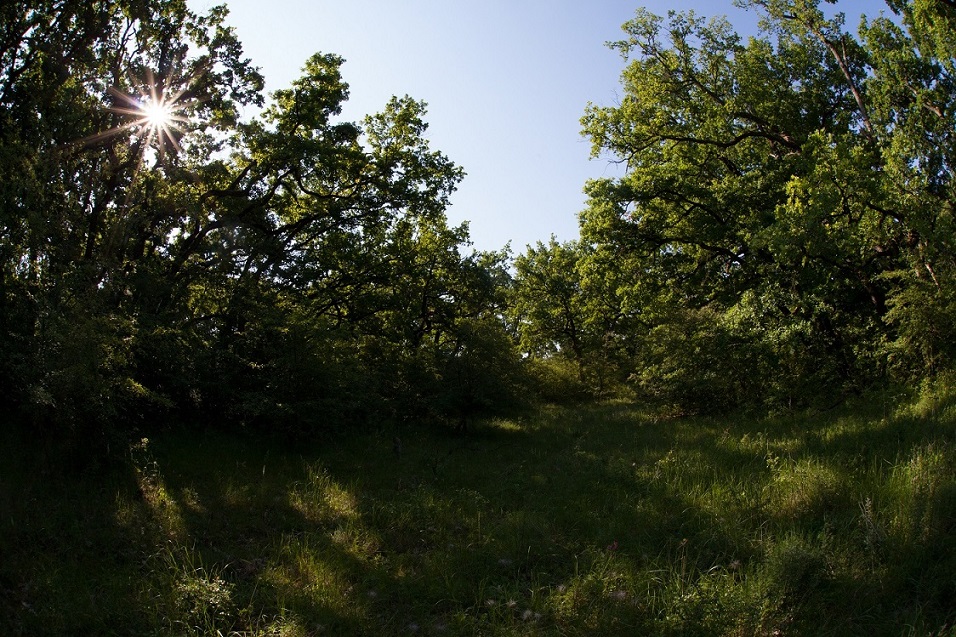Hajdúság Landscape Protection Area
1. Preface
The visitor venturing into the "eastern marches", leaving Debrecen and going towards Hosszúpályi, Vámospércs or Hajdúsámson perceives that the treeless plain of Tiszántúl and the ploughlands of Hajdúhát with great fields turn into varied woodlands which are full of dunes, forming the Partium across the border.
2. Geology, formation
Nyírség is the second largest wind-blown area of sand in our country, the remains of the 120-300 m thick alluvial cone which was piled up by the rivers coming down from the North-Eastern Carpathians and the western part of Transylvania, flowing through this area in the Pleistocene age. In the last ice-age the rivers began to flow in other direction owing to the sinking of the Plainland in the Szatmár-Bereg and the Bodrog area, so the wind assumed the main role in shaping the surface from this time.
The north winds of the last ice-age have formed the surface we can see now and built the characteristic, so called parabola-shaped and marginal sand-dunes with truncated westwards in about 0,5-1,5 km length and 18-20 m in height. Between them dips, valleys heading in the direction of North-East and South-West have been formed by the activities of ancient rivers, then they were partially deepened by the wind. These wet, plashy, low-lying marshy areas of birch forests without an outlet could have been formed in the final stage of the ice-age or in the next cool and wet period and they served as a refugee for the wildlife of this former age during the following drier and warmer periods as well, until the "regulation" of rivers started. As opposed to the vegetation of marshes and morasses in the low-lying marshy areas of birch forests, the vegetation characteristic for the dry sand-steppe has settled down on the sides of sand-hills, so various phytocenoses and community-complexes could develop, with gradual or sometimes sudden interchanges.
3. Conflicts between nature and humans
Although climate and natural conditions have changed a lot through the past millenium, the trasformation of nature has acceelerated only from the second part of the last century. The landscape known nowadays has been formed as a result of this process. The companies draining off the water from the low-lying marshy areas of birch forests have built drains to gather the water of these areas with or without outlets and diverted it to the Berettyó river from the end of last century.
The average amount of precipitation is about 550-600 mm a year, from which about 500 mm is lost only by evaporation. The farming activities carried out in the places of marshlands have remarkably increaed the desiccation of this region and decreased the level of the water table.
(To stop this process at least partly, a system of holiday ponds has been formed in the wooded plainland since the `70s). Long before the "regulation" of rivers in the 16-17th centuries, when the Partium and the town of Debrecen gave woods as taxes to the Porte, the size of forests began to decrease intensively and ploughlands, vineyards, orchards, meadows and sand-meadows took up its place. The situation got worse when the stock of residual woods was transformed and rapidly growing, drought-resistant Locust-tree, Black Pine, Scot's Pine, poplar trees and have been planted instead of oak trees since the end of last century.
Locust-tree, similarly to other tree species strange here, has destroyed the wildlife of this area. One does not have to be an ecologist to feel the crutial difference between the two types of forests. Having left the "church" of oak forests, entering the weedy acacia forests we can`t hear the song of birds and poplar plantations are ordered geometrically. Moreover, after the wood stocks having been cut and picked out, the land was ploughed deeply. So, almost all the plants with bulbs, tubers or rhizomes have disappeared from the vegetation having been the ornaments of these forests /Crocus reticulatus and Spring Bulbocodium/.
Forced and inconsiderate melioration of extensive farming areas which replaced small-peasant economy living in harmony with nature, programmes converting grasslands to arable lands to yield corn, the use of chemicals and the negative effects of recent privatization (cut rows of trees, groves, broken grasslands), all have topped off the process of the destruction of natural landscape. That is why rows of trees, groves, natural water table, sandy meadows and pastures have disappeared because of profit reasons.
4. Flora
4.1. Marshes
First of all, let`s visit the dips between sand-dunes, blownout depressions and so called birch-tree low-lying marshy areas of Nyirség. Mosaic-like plant communities form a typical pattern following the underlying water-table on the surface as well as pedological conditions. It also has preserved lots of plants preferring cool and wet climate e.g. Bogbean, White False Helleborine,Siberian Iris, Fringed Pink, Lax-flowered Orchid, Early Marsh Orchid, Globeflower, Marsh Gentian,Orange Hawkweed, mentioning only the plants caracteristic mostly of this area. The typical stages of the self-forestation of bogs are birch-tree marshes and bushy willow communities which are very common here.
4.2. Fresh oakforests
The final plant community of low-lying areas is the oak-ash-elm grove between sand-dunes. The foliage-level of this area is formed by the speciment of Pedunculate Oak, Hungarian Narrow-leaved Ash, Smooth-leaved Elm, Fluttery Elm, Silver Birch and different kind of poplar trees can be found in larger or smaller patches. The characteristic species of shrub-level are Red Dogwood,Alder Buckthorn, and Guelder Rose.
The valuable plants in its ground-level are Bulbous Corydalis and Solid-tubered Corydalis, Large White Helleborine and Narrow-leaved Helleborine, Narrow-leaved Helleborine, Martagon Lily.
The valley lily Pedunculate Oak forest appears on higher, still fresh places. Its foliage-level consists of Pedunculate Oak, Field Maple sometimes Tatarian Maple, Wild Pear, Bird Cherry, and different lime-tree species.
The very specific Silver Linden spreaded from the Balkans through Transylvania to Sub-Carpathia forms e.g. a nice remnant wood at Bagamér. Birch- and various poplar-trees are not rare in these forests as well. The outstanding shrub species are the following: dog-berry som Red Dogwoodwhich is excellent food for song birds (even the Cornelian Cherry in Gúth, too), Spindle-tree,Blackthorn, Common Hawthorn, Hazelnut and Common Privet. The grass-level of oak forests is rich in several spring bulbiferous plants, Lily of the Valley, and various Solomon`s seal species. Its rare, protected plants are: Alpine Squill, Greater Butterfly Orchid and Lesser Butterfly Orchids, Bird`s Nest Orchid Bird's Nest Orchid, Snowdrop Windflower Showdrop Windflower and Bulbous Corydalis, Solid-tubered Corydalis, Round-leaved Wintergreen, Cowslip, etc.
4.3. Sand grasslands, sand partures
Visiting the drier areas we can still find plenty of sandy grasslands and pastures, the latter differs a bit from the relatively injuried grassland community (e.g. at Bagamér, Monostorpályi, Hajdúbagos, Hajdúsámson, etc.). Green-winged Orchid, Sandy Iris, Yellow Everlasting and Baltic Golden Drop can also be found in sandy grasslands.
4.4. Sandy Oakforests
Only very few sandy oakforests formed by self-forestation on sandy-hill tops have remained by now. Wide-spread clearings and closed sandy grassland formed on it are characteristic of these forests which are often very rich in plant species. Sometimes we can find Silver Linden, White Poplar and even Juniper+, too. There are Common Hawthorn, Common Privet and Hazelnut in the rich shrub-level but the latter is getting rare because of aridity. Broad-leaved Helleborine and purplish blue Hungarian Stool Iris as most outstanding plants flourish on grass-level (the latter one can be seen on the 20 forint coin on a day to day basis).
Some other remarkable plants are the following: the Melampyrum nemorosum subsp. debreceniense, Yellow Pheasant's-eye, Large Yelow Foxglove Large Yellow Foxglove. The plants of sandy grasslands also occur on the clearings, moreover, their original habitats might be situated in sandy oakforests. The Crocus reticulatus and Spring Bulbocodium are kept in evidence as the most excellent values of the landscape. Establishing a carpet-bed these plants are the nicest values of early spring at some places.

5. Fauna
Although our region is mostly famous for its botanical values, protected animal species are also precious here.
So it is absolutely necessary to mention two insect species characteristic of dry sandy grassland: predacious Praying Mantid and Long-headed Grasshopper, the latter being the endemic species of the Carpathian Basin. Walking along the paths of sandy grasslands, the Hungarian Tiger Beetlecomes into sight. The number of Stag Beetles and Great Capricorn Beetle. speciments characteristic of old oakforests has decreased considerably. Rhinoceros Beetles living in rotten oak trees are getting extinct.
Somewhere in the edges of oakforests we still meet Southern Festoon, Swallowtail and Scarce Swallowtail speciments. The valuable species of bogs is Lycaena dispar hungarica and walking in humid ash-forests the most valuable species, the Scarce Fritillary appears in the edges of forests.
Out of vertebrates, the protected fish species in stagnant waters is worth mentioning: Mud Loachoccuring relatively often. Wetlands and their environment give home for different amphibian species Smooth Newt and Warty Newt (Tritulus cristatus), a frog named Rana arvalis, Fire-bellied Toad, etc.)
We have to emphasize the importance of the Balkan Wall Lizard living in smaller, scattered populations in sandy steppe grasslands, the Sand Lizard with red back which is very striking in the sunny edges of forests, Green Lizard and the Viviparous Lizard, the rare valuable lizard of marshy meadows. We would stress the importance of four mammalian species: the European Souslik living in great strenght in sandy pastures which entices birds of prey to the "layed table" offered by it, the endemic Lesser Mole Rat living only in some isolated populations (Hajdúbagos), the Otter fishing in ponds and brooks, the Wildcat occuring in larger forests (Gúth). In addition to the animals above. Finally, let`s say some words about avifauna. The varied vegetation of wooded steppe contributes to the development of rich song-bird fauna. It is exteremely true referring to oak-ash-elm forests with their rich shrub-level which are interrupted by clearings and communities of still alive centuries old oakforests. The Roller nesting in the natural cavities of oldWhite Poplars has an outstanding importance in nature protection, so does the decorative Bee-eater which lives in the walls of sand-pits. Among aquatic birds, it is worth mentioning the species of Great Crested Grebe, Black-necked Grebe, Red-necked Grebe, Ferruginous Duck andWhiskered Tern all of which breed on the storage-lakes. Corncracke is getting wide-spread in bog-meadows again, and numerous pairs of Black Storks hatch in old undisturbed oakforests. Besides birds of prey nesting here, we have to pay attention to other predators appearing above the wetlands regularly e.g. Osprey and Short-toed Eagle, to the Lesser Spotted Eagle, occuring in marshy meadows, too. We have not yet mentioned White-tailed Eagle which wanders about here in winter and Saker Falcon. which can be seen much more frequently.
Picking out some examples from this extremely incomplete list verifies that the wildlife of South-Nyirség wooded plainland hides values which are significant even now. The protected areas listed below mean to preserve the habitats of species and the harmony of the land which still exits now.
6. Protected areas
6.1. Districts of Landscape Protected Areas in Hajdú - Bihar Country
In 1988 a forceful stand was taken almost in the last possible second when patches of wooded plainlands containing living native stands of hidden, rare plants, unploughed marshy meadows and pastures were placed under conservation. These were situated on a 5680 hectar area (it has since been enlarged by more than 7000 hectares). As these lands are mostly on the southern part of the former Hajdú country, this mosaic of the protected areas was baptized as a Landscape Protected Area of Hajdú-Bihar County. But we are in Nyirség, on its southern and south-eastern watershed areas, in the "little land" of South-Nyirség both geographically and phytogeographically. So after the recent enlargement of the Lanscape Protected Area, the name will be perhaps modified to` Wooded Plainland Landscape Protected Area` in South-Nyirség.
In spite of the changes, the landscape has preserved a lot from its ancient features and as a result of the recent measures of environmental protection, original nature has shrivelled up to island-like relic patches. This is why the landscape protectional area is scattered and mosaic-like.
The 28 areas under protection can be found at the boundaries of the following settlements: Álmosd, Bagamér, Debrecen, Fülöp, Hajdúbagos, Hajdúsámson, Hosszúpályi, Kokad, Létavétres, Monostorpályi, Nyirábrány, Nyiracsád, Újléta and Vámospércs.
The boundary of Álmosd and Bagamér is crossed by the so called Kék-Kálló or No 2 main flow in southern direction in the valley of which we can find all the specific habitats of the Nyirség from sand-dunes of the notable Daru-hills (or Malomgát), through low-lying marshy birch forest areas of Daru-marshes extended to Kokad or Létavértes to the uniqe silver linden-oak forest which covers the steep slopes of sand-dunes. There are some small sandy oakforest patches near the silver linden-oak forests, in the boundary of Vámospércs which are the last curiers of vast sandy oakforests.
Bánk, Haláp, Pac, Nagycsere and Fancsika, the former domains of the town Debrecen still guard some endemic woody and meadow phytocenosis, e.g. the ash-tree arboretum in Nagycsere, the hardwood forest at Gúthi-ér (stream) which was proposed for protecion by Rezső Soó, the Rashbauer oakforest and its environment at the skirts of Haláp. Several valuable remains of sandy oakforest and valley lily oakforest can be found in a continual forest line between Haláp and Bánk : e.g. the oakforest in Állóhegy next to the forestry of Haláp, the forest in Pipó-hegy and the surroundings of the former Ludas csárda (inn).
Birch-oak forests, some nice marshy meadows and grassland make the landscape more colourful. The following issues are under protection here: a part of the oakforest in Mézes-hegy hiding several curious plants, willow-tree meadows, wet grassland, ponds near Bánk on the other side of the so called Diószegi highway which leads towards Transylvania and was the pathway of salt transport in the past. We have to mention the last habitat of crocus in Pac and the remains of the church of the Arpadian age in the former settlement called Parlagh, next to the recent Dombos-tanya. The two recreational ponds in the wooded plainland with natural conditions are the Bodzás and the Halápi storage-lakes. They are of great importance owing to the nesting and feeding places here.
The remains of a Sarmatian earthwork system of the migration period, the so-called "Devil`s Ditch" divides the Lesser Mole Rat reserve situated North of Hosszúpályi from the forest which consists of some old Tatarian maple oakforest patches. These recall the wide-spread steppe oakforests. The protected area ranges from the boundry of Hosszúpályi to the highway from Debrecen to Hosszúpályi.
Being situated on the field of the Nyirség the two other districts of Hossszúpályi (South of the village) belonging to the landscape protected area are typical "szoloncsák" alkaly-marshy region in Bihar County. This region totally differs from the other parts of the landscape protected area in the Nyirség relating features and wildlife. A storage-lake was formed in the place of the marsh called Sándorosi, next to the former bathing resort, Konyár-Sóstó in the 1970s. This storage-lake together with Kócsiklapos situated at the foot of one of the barrows characteristic of this region and Kerekfenék drying in summer, plays an important role in the migration of birds in autumn and spring because they are nesting and feeding places for birds and well-known everywhere in the world.
The meadow called Martinkai joined up with an oakforest is known to be one of the largest sandy regions spotted by steppe grassland, wetter meadows and low-lying lands and it is situated south of Hajdúsámson.
Létavértes is also situated in the Nyirség. The ploughlands of good quality can be found in the place of loess grasses south of the settlement. They are interrupted by a geologically, archeologically and botanically interesting so called loess-wall spreading towards Pocsaj. It has become protected lately. North of the village there are various sandy areas rich in reeds, marshes, willow-poplar communities. The protected area spreads over Újléta where the rest of a birch-tree low-lying area, the so called Nagy-Ócsa grassland is bordered by steep sand-hills from the north. The illustrious "Kiserdő" covering one of these sand-hills preserves the largest population of Spring Bulbocodium. Létavértes is also famous for its vineyard in Mosonta-mountain where ethnographical and scenic values are under protection.
The nicest region of the landscape protected area extends from the north of Monostorpályi to the Diószegi highway. In its upper, northern part meadows spread along Kis-pályi ér (stream) providing awe-inspiring sights even now. So do oakforests growing on the hill-lines of Csikgát where meadows are surrounded from the west.
The environment of Nyirábrány has got the greatest number of marshy meadows. The Káposztás-lapos and the birch-tree bog at Kesler-tag rivalling the one in Bátorliget can be mentioned. The birch-tree bog is bordered by the deepest typical parabola dune of the LPA and gives a nice sight overlooking the neighbouring village.
The so called "Mogyorós erdő", the marshy and meadowy forest distinguished by its inner marshy meadows, is abound in plenty of protected values. So we can say that it increases the importance of the grass which is situated north of the roadway towards Nyiracsád and varied by plashes and sandy hillocks (which are typical examples of various phytocenosis-mosaics in the Nyirség). Its `little syster`, the so called "Bereki-erdő" is a nice remnant of a hardwooded forest community near Budaábrány, situated at the bend of Konyári kálló. The marshy meadow of the Hanelek region spreading also to Fülöp is going to be placed under protection in a short time.
The forest in Külső Gúth, which used to be the pearl of the external domains of Debrecen, can be found north of Nyiracsád. Unfortunately, there are lots of plantations in the place of the ancient oakforest of the widest expansion in the Nyirség. Only some old oakforests defy the challenges of time in certain parts that has been placed under protection. The Jónás-rész is situated next to Buzitatanya in the southern corner, in the boundary of the village. Its sandy meadow gradually turns into the largest aridating plain marsh of the landscape protected area and it is partly covered by a forest housing several botanical rarities.
A varied habitat-complex extends in the eastern direction of Vámospércs, from road No 48 to the region mentioned above. This landscape shows us the former beauties of the Nyirség ranging from the area of low water-level called Villongó to the dry sandy grassland, from the ash forest community to the meadow with seed-trees on it.
The extension of the landscape protected area proposed for protection is shown on the synoptical map.
6.2. Locally protected areas of the neigbourhood
The town of Debrecen has placed several wooded plainlands under protection. These are the following:(NPA= Nature Protected Area)Wooded Plainland NPA., Meadow NPA in Haláp, Robinia Forest NPA in Hármas-hegy, Galery Forest (Oak-ash Forest) NPA in Haláp, Aspen Forest NPA at Nagycsere-Martinka, Oakforest NPA at the skirts of Haláp, Native Marsh NPA.
Other protected areas: Black Pine Forest NPA in Monostorpályi, Sandy Oakforest in Bocskaikert, Informal Garden in Téglás.
6.3. Cultural - historical values
Although the area does not possess plenty of monuments known all over the country, the visitor keeping his eyes open can meet several values. Here are some of them:
Álmosd:
It may be the most famous settlement of this area. We shall pick out five of the uncountable sights now. The house of the poet of our national anthem, Ferenc Kölcsey is almost respected as a sanctum.
The famous, great poet lived in this thatched white painted house built of Classic style from 1812 to 1815. Today it serves as a library including a literature memorial exhibition. The Kölcsey statue made by László Márton stands in the garden.
There is a nicely renovated smithery which preserves the relicts of smithcrafts in he neighbourhood the Kölcsey`s house.
The one-storey country-house of the Miskolczy family related to Kölcsey, together with its tree-Methuselahs and the ancient cemetery is situated in the outskirts of the village.
There was a remarkable battle between Bocskay`s soldiers and the Austrian soldiers in the boundary of Álmosd and Bihardiószeg on 15th October 1604. The exhibion of the Kölcsey Memorial Museum and the monument standing on the battlefield commemorate general Sándor József Nagy. So does the military statue illustrating five figures, standing in Fő tér.
The present feature of the reformed church was formed by the reconstruction (1805) of a Gothic church in about 1400. Looking from the south a marvellous sight can be seen, so we can imagine the former medieval church fortress standing next to the brook.
Discovering from the south how strongly-built it is, you can imagine the power of the former medieval church fortress. The aisleless church with buttresses standing next to the brook is a marvellous sight. You should see this and its sanctuary with an octagon base and with five walls standing outdoors.
Bagamér:
This settlement next to the Romanian border used to be a considerably important traffic junction of the Érmellék until the time of the peace treaty accepted in Trianon. Only the street-net and the settlement structure have remained by now. The nicest and mostly organized streets are in the western part of the village.
The reformed church built on a high hill origins partly from the Middle ages and the two chalices which are guarded in it were made in the 15th century. Mihály Vitéz Csokonay has written his poem entitled "For Eve`s Nameday " here.
The Numidian fir (Abies numidica) trees of 35 m high in the main square and the giant White Poplar tree-Mathuselahs (the trunk width is more than 7 m) on the Takó-hegy are really popular among nature worshippers who hardly meet older trees (they are protected fortunately).
Hajdúsámson:
The settlement structure of Hajdúsámson imitates rays of radiation, similarly to other villages in Nyirség, so the reformed church stands in its centre. The rings of an earthwork can be seen in the south -eastern vineyard of this settlement and Hajdúbagos. The name of "Diósvár" resembles the existence of another earthwork in the northern skirts of Hajdúsámson.
Nyirmártonfalva:
The forestry`s office block was built in the depth of the forest of Gúth in about 1885. Its middle part used to serve as an officer`s accomodation and the one-story wings of the building as a peronnel residence. The Eclectic frontage is simmetric as usual and shows a middle projectonal arrange but the central protuberant part of the building was combinated by a tower. Its top has already been rebuilt in some ways. The little hipped roof, the planked gable and wooden spire remind us of the folk architecture in Szatmár County in Transylvania.
The Classic castle constructed in the middle of 1800s by the count József Reviczky on the top of a little hill is in the forest of Gúth. As the count did not live here the castle might have been used as hunting place because the forests near here were rich in games. This quality building with a uniform style has a frontage with three arches and a tympanon which is similar to the public buildings of Debrecen constructed at the same time. Going through the spacious hall with a passage in its centre, we can get into the former Hunter`s room. The two ends of the long building are closed by the sightly salient lateral projections. It is an educational establishment.
Nyiracsád:
The renovation (1988) of the present reformed church shows a sensational result. The former church from Arpadian age was built in the 13th century in early Gothic style. It has a square shaped (straightly closed) sanctuary. The ground-plan of the nave is of rectangular shape. The inner church has three extremely valuable wall-paintigs. The marvellous bishop figure`s contours made in the end of 14th century can be seen on the triumphal arch. The paintings on the northern wall are supposed to symbolize the birth of Virgin Mary and the scene from the legends about Saint László. In the sanctuary a row of pictures originating from the 15th century resembles the events happened on Golgota. Finally, a signature written in the 17th centuy tells the story of the establishment of this whitewashed reformed church. After unfolding the three coatings of paint, the reconstructed church has become the "pearl" of the Nyirség.
Fülöp: (formerly: Bánháza)
Bánháza used to be a densely populated settlement in the Middle Ages but it was completely destroyed under the Turkish rule. The countess, Mrs Keglevich had the chapel constructed in 1796 and it was consecrated to the honour of Virgin Mary. The chapel is said to have been built using the remains of the Serbian church and the bricks were burnt on the spot.
Nyirábrány:
The settlement was established by the union of the parts called Ördög-ábrány and Budaábrány. Eördögh castle was constructed on the back of a sand-dune in Nyirség, in the northern part of this settlement (Ördög-ábrány) in 1827. This is the best buildig of the famous architect Ferenc Povolny (who has planned the nine-arch bridge in Hortobágy, too). One can walk to his own liking under the more than hundred year old trees of the park belongs to the castle and view the wounderful Classic building.
Vámospércs:
It was an ancient town where the Heyducks lived and one of the places taking toll in the Middle ages. Its reformed church was built in late-Baroque style on a high hill in the centre of the village in 1802. Artúr Görgey standing in its tower observed the troop movements of general Sándor József Nagy withdrawing from the vanquished battle in Debrecen on 2nd August 1849. It was he who conferred with Lajos Kossuth in the more than 200 year old parish hall.
Let`s mention about this large village that the structure of its northern part looks like a labyrinth built on a hill. It is a perfect wonder. It is worth taking a walk here.
"Devil`s Ditch":
The sign of a long earthwork " not coming from anywhere and not going somewhere" can be seen in many places of our area (Debrecen-Nagyerdő, Debrecen-Nagycsere, Hajdúbagos-Mole less rat Reserve, Dombostanya, Nyirábrány, Nyiracsád). Its origin and its goal have been researched and discussed still now.
According researches, the Sarmatians living here built this earthwork with the help of Romans restarting several times to fend off or stop the attack of Barbarians coming from East after 322. The reconstruction was realized according to this conception along the highway leading to Vámospércs in the forest between Debrecen and Nagycsere and can be seen in its full beauty.
Earthworks:
Several earthworks seem to have been built next to the ditch system in our county to observe and defend these ditches. We have only few information about these military garrisons. They have not yet been investigated. Let`s have a list. Hajdúsámson: Diósvár and earthwork in vineyard, Bánk: earthwork, the earthworks of Hajdúbagos and Hosszúpályi and a so called "Erőslyuk" in Nagycsere.
Tumuli:
We can hardly see tumuluses between the sand-dunes of Nyirség but there are numerous ones in the periphery of Hosszúpályi, Hajdúbagos, Monostorpályi belonging to the authority of the Landscape Protection Area in Hajdú-Bihar County. Some of these tumuluses are inside protected areas. As silent witnesses of history lasting for a millenium, these tumuluses preserve the signs of people`s activities down here during the migration period or earlier ages. (Barrows outside the protected areas are also controlled by laws.)
Churches, church remains:
The church architecture of South-Nyirség can be traced back to the 11-12th centuries. Some of our medieval churches can be seen in their original condition or a bit modified form (Álmosd, the reform churches of Nyiracsád in which unique frescos decorate the walls). Most of them have been reconstructed. As a result of scientific research we have already known the works of the Premonstratensian, Cistercian, Johannitan and Benedictine building masters` places operating here in the 12-13th centuries. Having recovered the relics by archeologists, some of these churches can already be seen.
A short access road leads to the forest between Nyiradony and Nyiracsád on the clearings where red brick walls stand. This church was the Guthkeled clan`s property who had their monastery built in Adony (Nyiradony). It can be supposed that the friars could not perform the tasks of parsonage as well, so the building of a new independent church was needed in Gúth near Adony.
The places of several destroyed medieval villages in the wooded plainland are already well-known to the eastwards of Debrecen but only some of them had churches. The reconstructed foundation walls of the church in Fancsika can be seen on the Templomhegy at the meeting-spot of the Panorama and Diószegi highways south-east of Debrecen. The visitors can also find the relicts of a very interesting church with four foils of Újlakszentjános in the southern corner of Nagycsere.
The restored relics of the church of a mediaeval village called Parlag stand westwards about 800 m away from the railway station in Dombostanya, in the south-eastern skirts of Debrecen. The building enlarged several times since the 12th century was ruined by earthquakes. Parlagi, the greatest family of this country-side had a Gothic church with inorganic plygonal sanctuary was constructed in that place in the 15th century. After the reconstruction these century old walls serve as a monument of this mediaeval village, one of the important places preserving the Christian tradition.. The beauty-spot around the remains is protected and it is a pleasant place for excursions very close to the town.















